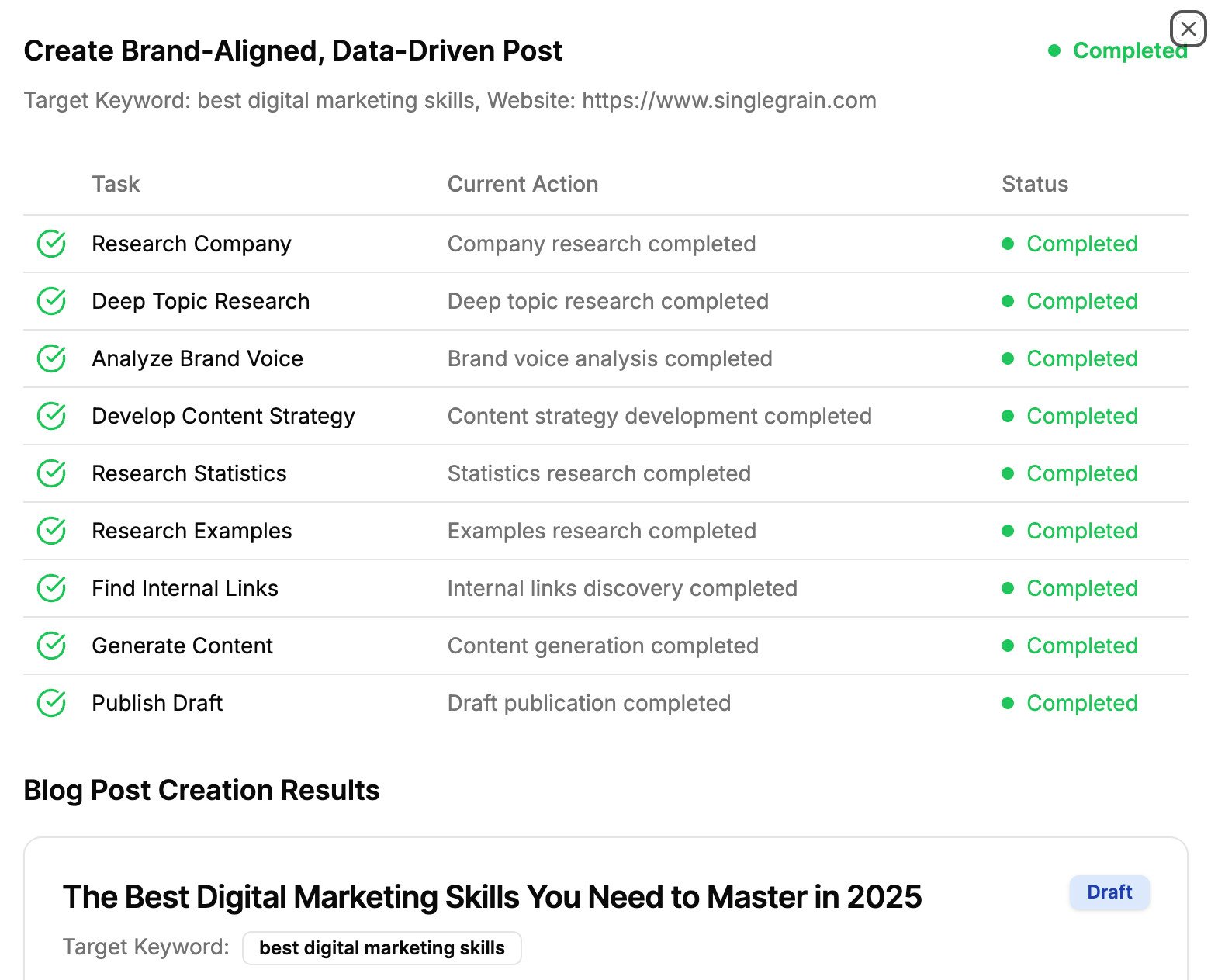When Zenpli implemented Vertex-AI-powered automation across their marketing operations, the results weren’t just impressive. They were transformational. The company cut operational costs by 50% and accelerated client onboarding by 90%, proving that AIO (Artificial Intelligence Operating) marketing isn’t just about efficiency gains. It’s about fundamentally reimagining how businesses scale.
For marketing executives and managers facing increasing pressure to deliver measurable growth while optimizing spend, AIO marketing represents the bridge between ambitious targets and operational reality. Unlike traditional marketing automation that simply digitizes existing processes, AIO marketing creates entirely new operational paradigms that scale exponentially rather than linearly.
Key Takeaways
- Key takeaways will be added soon.
TABLE OF CONTENTS:
Understanding AIO Marketing’s Operational Transformation
AIO marketing transcends conventional marketing technology by embedding artificial intelligence into every layer of your marketing operations. While traditional approaches require manual intervention at multiple touchpoints, AIO systems create self-optimizing workflows that improve performance autonomously.
The fundamental difference lies in how these systems process and act on data. Traditional marketing platforms collect information and present it for human analysis. AIO marketing platforms analyze, decide, and execute. Often within milliseconds of data collection. This operational shift enables marketing teams to focus on strategy and creativity while AI handles execution and optimization.
“The most successful AIO implementations don’t just automate existing processes, they redesign them entirely around AI capabilities, creating operational leverage that compounds over time.”, Harvard Business School Research on AI Factories
The Three Pillars of Operational Scaling with AIO
Intelligent Process Automation
The first pillar centers on transforming manual, time-intensive tasks into intelligent, self-managing systems. Sage Publishing exemplifies this transformation, having cut content writing time by 99% and halved marketing costs through AI-powered content generation. Their system doesn’t just create content. It adapts style, tone, and messaging based on audience data and performance feedback.

This level of automation extends beyond content creation to encompass campaign management, audience segmentation, and performance optimization. When implemented strategically, intelligent process automation creates operational capacity that scales without proportional increases in headcount or overhead.
Predictive Campaign Orchestration
The second pillar involves leveraging AI to anticipate market conditions and customer behavior, enabling proactive rather than reactive marketing strategies. Bayer’s implementation demonstrates this principle masterfully. Their AI system analyzes Google Trends, climate data, and machine learning models to predict flu season outbreaks, automatically triggering relevant health product campaigns.
The results speak to the operational impact: an 85% year-over-year increase in click-through rates, 33% lower cost-per-click, and 2.6× growth in website traffic. More importantly, these improvements occurred without increasing marketing team workload, as the AI system managed campaign timing, budget allocation, and creative optimization autonomously.
Real-Time Optimization and Learning
The third pillar focuses on continuous improvement through real-time data processing and decision-making. This goes beyond A/B testing to encompass dynamic optimization that adjusts campaigns, messaging, and targeting based on live performance data.
| Traditional Marketing Operations | AIO Marketing Operations | Operational Impact |
|---|---|---|
| Weekly performance reviews | Real-time optimization | 50-90% faster response times |
| Manual audience segmentation | AI-driven micro-segmentation | 300% improvement in targeting precision |
| Static campaign creative | Dynamic content optimization | 85% increase in engagement rates |
| Reactive budget management | Predictive spend allocation | 33% reduction in wasted ad spend |
Enterprise Success Stories: Operational Excellence in Action
Leading enterprises across industries are demonstrating how AIO marketing creates sustainable competitive advantages through operational transformation. Coca-Cola’s AI-driven approach to audience micro-segmentation represents a masterclass in scaling personalization without losing operational efficiency.
By embedding an AI-driven operating model that analyzes first-party interaction data and social media signals, Coca-Cola creates dynamic micro-segments and serves highly tailored ads across channels. The operational impact extends beyond improved targeting. Their system manages thousands of campaign variations simultaneously, something impossible with traditional manual processes.
The financial results validate the operational transformation: sales climbed 3% to $12.4 billion during their implementation period, while customer engagement scores rose sharply. More critically for operational leaders, these improvements occurred while maintaining existing team structures, demonstrating that AIO marketing amplifies human capability rather than replacing it.
Building Your AIO Marketing Foundation
Successful AIO marketing implementation requires strategic planning that aligns technology capabilities with business objectives. The most effective approaches begin with identifying high-impact, low-complexity processes that can demonstrate immediate ROI while building organizational confidence in AI-driven operations.
Data infrastructure represents the critical foundation. Bradesco Bank’s implementation of Azure OpenAI Services into their virtual assistant achieved an 89% client-retention rate precisely because they invested in integrated data systems that enabled personalized, contextual interactions at scale.
The operational transformation occurred gradually, starting with customer service automation and expanding to predictive analytics, personalized product recommendations, and proactive engagement strategies. This phased approach allowed their teams to adapt to new workflows while maintaining service quality throughout the transition.
Key Implementation Considerations
- Technology Integration: Ensure your AIO platforms integrate seamlessly with existing marketing technology stack, particularly CRM systems and analytics platforms
- Team Readiness: Invest in training programs that help marketing teams understand AI capabilities and limitations, fostering collaboration rather than replacement anxiety
- Performance Metrics: Establish clear KPIs that measure both operational efficiency gains and business outcome improvements
- Governance Framework: Implement oversight processes that ensure AI-driven decisions align with brand values and regulatory requirements
The most successful implementations also establish feedback loops that enable continuous improvement. Modern AI marketing tools excel when they can learn from campaign performance and user interactions, adapting strategies based on real-world results rather than static programming.
Measuring ROI and Operational Impact
Quantifying AIO marketing success requires metrics that capture both immediate performance improvements and long-term operational benefits. Traditional marketing metrics provide part of the picture, but operational scaling demands additional measurement frameworks.
Process velocity represents one critical metric. Banco Covalto’s experience illustrates this perfectly. Their deployment of generative-AI workflows cut credit-approval response times by more than 90%. While this specific example applies to financial services, the principle translates directly to marketing operations: AI systems enable faster decision-making across campaign optimization, content creation, and audience targeting.
Resource allocation efficiency provides another essential measurement dimension. When marketing teams can accomplish more strategic work because AI handles routine optimization and reporting, the operational impact compounds over time. Organizations should track hours saved, creative output increased, and strategic initiatives completed as direct benefits of AIO implementation.
For marketing leaders seeking comprehensive performance analysis, specialized analytics platforms can provide detailed attribution modeling and ROI tracking specifically designed for AI-powered marketing operations.
Strategic Next Steps for Operational Transformation
The transition to AIO marketing operations requires deliberate planning and phased execution. Begin by conducting a comprehensive audit of current marketing processes, identifying bottlenecks and manual touchpoints that could benefit from intelligent automation.
Prioritize implementations that offer measurable impact within 90 days while building toward longer-term operational transformation. This approach generates momentum and stakeholder buy-in while establishing the data infrastructure necessary for more sophisticated AI applications.
Consider partnering with agencies that specialize in AI-powered marketing transformation to accelerate implementation timelines and avoid common pitfalls. The expertise gained from managing multiple AIO implementations can significantly reduce time-to-value while ensuring best practices adoption.
Most importantly, approach AIO marketing as an operational philosophy rather than a technology deployment. The companies achieving transformational results view AI as a fundamental component of their marketing operations, embedded into strategy development, execution, and optimization processes.
The evidence is clear: AIO marketing delivers measurable operational advantages for organizations ready to embrace intelligent automation. From 50% cost reductions to 90% faster processes, the benefits extend far beyond efficiency gains to encompass competitive positioning and market responsiveness. The question isn’t whether to implement AIO marketing. It’s how quickly your organization can adapt to this new operational reality.
Ready to turn those 50% cost reductions and 90% efficiency gains into your reality?
Related Video
For more insights and lessons about marketing, check out our Marketing School podcast on YouTube.
Frequently Asked Questions
-
What's the difference between traditional marketing automation and AIO marketing?
Traditional marketing automation digitizes existing processes and presents data for human analysis, while AIO marketing creates entirely new operational paradigms where AI analyzes, decides, and executes within milliseconds. AIO systems are self-optimizing and improve performance autonomously, enabling exponential rather than linear scaling.
-
What are the three core pillars of AIO marketing operations?
The three pillars are: Intelligent Process Automation (transforming manual tasks into self-managing systems), Predictive Campaign Orchestration (using AI to anticipate market conditions and customer behavior), and Real-Time Optimization and Learning (continuous improvement through live data processing and decision-making). Together, these pillars enable marketing teams to focus on strategy while AI handles execution.
-
How much can businesses realistically save by implementing AIO marketing?
Real-world implementations show significant cost reductions, with companies like Zenpli cutting operational costs by 50% and accelerating client onboarding by 90%. Other success stories include Sage Publishing reducing content writing time by 99% and halving marketing costs, while Bayer achieved 33% lower cost-per-click with their AI-powered campaigns.
-
What should companies prioritize when starting their AIO marketing implementation?
Begin with a comprehensive audit of current marketing processes to identify bottlenecks and manual touchpoints. Prioritize high-impact, low-complexity processes that can demonstrate ROI within 90 days while building organizational confidence. Focus on data infrastructure first, as integrated data systems are critical for effective AI-driven personalization and automation.
-
How do you measure the success of AIO marketing beyond traditional metrics?
Measure process velocity (how much faster decisions are made), resource allocation efficiency (hours saved and strategic initiatives completed), and operational capacity gains. Track both immediate performance improvements like engagement rates and long-term benefits like reduced manual intervention and increased creative output from marketing teams.
-
What team preparation is needed for successful AIO marketing adoption?
Invest in training programs that help marketing teams understand AI capabilities and limitations, fostering collaboration rather than replacement anxiety. Establish clear governance frameworks to ensure AI-driven decisions align with brand values, and create feedback loops that enable continuous improvement based on real-world campaign performance.
-
Can AIO marketing work with existing marketing technology stacks?
Yes, but seamless integration with existing systems is crucial for success. Ensure your AIO platforms integrate well with current CRM systems, analytics platforms, and marketing automation tools. The most successful implementations build upon existing data infrastructure rather than replacing entire technology stacks.





